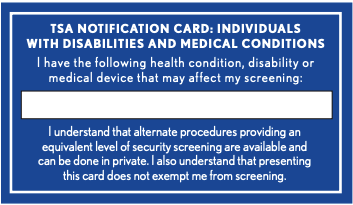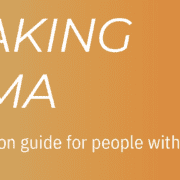TRAVELING WITH AN OSTOMY
Since extra security precautions are still being taken at airports and other transit hubs worldwide, a little pre-planning and understanding of both security rules and your right to privacy can help you avoid problems in transit and enjoy your travels.
• TSA officers should NOT ask you to show your pouch—you may be asked to rub over your pouch outside your clothing so they can test your hand to rule out explosive residue.
• In particular, remember that all airport screenings must be conducted with courtesy, dignity and respect. You may request screening in a private area at all U.S. airports and most international destinations. If you encountered treatment outside of TSA protocol you can file a complaint, (please copy UOAA’s volunteer TSA Liaison gfsalamy@comcast.net)
A few additional tips to keep you on the go:
Carry a statement from your healthcare professional stating your need for ostomy supplies AS WELL AS a Travel Communications Card (which can be found here.)


TSA rules state that you can be screened without having to empty or expose your ostomy; however, you may need to conduct a self pat-down of the ostomy as a test.
NOTE: You may always have a travel companion with you during a private screening.
If you are traveling to a foreign country, bring this information written in the appropriate language. Google Translate may be helpful with translations. If you find you need additional supplies while traveling, a local pharmacy is a great starting point. The local pharmacist should be able to provide you with the necessary supplies and/or refer you to a local clinic/hospital for support.
Pre-cut all cut-to-fit barriers at home. Although current United States Transportation Safety Administration (TSA) rules allow curved point scissors with blades less than 4″ in length in your carry-on luggage, keeping your ostomy scissors in your checked luggage may avoid delay and extra screening
Consider purchasing travel insurance that guarantees getting you to a hospital, if necessary.
When it comes to supplies, OVERPACK! Better safe than sorry. Pack at least three days’ worth of ostomy supplies in your carry-on luggage, just in case your checked luggage is misplaced or there are delays and/or non-availability at your destination.
Drink, drink, drink. Nothing slows down a vacation more than dehydration.
If traveling by car, take advantage of rest areas. Stop and empty your pouch regularly; you never know how far it will be until the next one!
Pack ostomy-friendly snacks.
Keep a set of clean clothes handy whether in your carry-on luggage or in the trunk of your car.
Carry a few plastic bags and wet wipes for quick clean-up.
The idea of taking long trips with an ostomy can seem daunting. But with a little extra preparation, you can enjoy the trip of a lifetime.
Editor’s note: This blog is from one of our digital sponsors, Convatec. Sponsor support along with donations from readers like you help to maintain our website and the free trusted resources of UOAA, a 501(c)(3) nonprofit organization.













Do they make larger bags. I’m on dialysis and it’s been filling up before I’m done. They need to disconnect me , so as to go to the bathroom.
All of the major manufacturers (Hollister, Coloplast, ConvaTec, etc.) make high-output pouches which have larger capacity than their regular pouches.
When traveling with Ostomy bag does the cabin pressure affect the bag?
We are wondering the same thing.
How does the pressure in The plane effect the pouch?
But as I type this. I guess it wouldn’t because the pressure in the cabin is kept at the leave so we can live and breathe so pouch shouldn’t be effected!
I have had my ileostomy for 15 years and have traveled all over the world. The cabin pressure does not affect the stoma or the bag (doesn’t make it fill up with gas). I have noticed my pouch is more smelly after flying, even with the use of M9 deodorizer drops, so I generally change my appliance after I arrive at my destination.
How do I get a TSA travel card?
Go to our page at https://www.ostomy.org/ostomy-travel-and-tsa-communication-card/ and follow the link labeled UOAA’s Travel Communication Card.